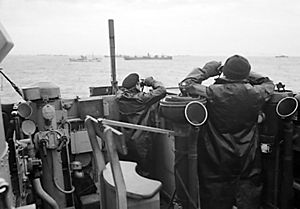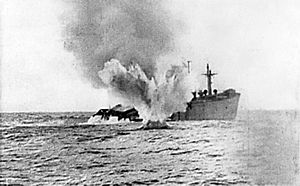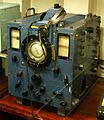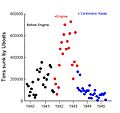Battle of the Atlantic facts for kids
Quick facts for kids Battle of the Atlantic |
|||||||
|---|---|---|---|---|---|---|---|
| Part of the Second World War | |||||||
 Officers on the bridge of an escorting British destroyer stand watch for enemy submarines, October 1941 |
|||||||
|
|||||||
| Belligerents | |||||||
|
List
|
|||||||
| Commanders and leaders | |||||||
| Casualties and losses | |||||||
| 36,200 sailors killed 36,000 merchant seamen killed 3,500 merchant vessels 175 warships 741 RAF Coastal Command Aircraft lost in anti-submarine sorties |
783 submarines lost 47 other warships lost 17 submarines lost |
||||||
The Battle of the Atlantic, the longest continuous military campaign in World War II, ran from 1939 to the defeat of Nazi Germany in 1945, covering a major part of the Naval history of World War II. At its core was the Allied naval blockade of Germany, announced the day after the declaration of war, and Germany's subsequent counter-blockade. The campaign peaked from mid-1940 through to the end of 1943.
The Battle of the Atlantic pitted U-boats and other warships of the German Kriegsmarine (Navy) and aircraft of the Luftwaffe (Air Force) against the Royal Navy, Royal Canadian Navy, United States Navy, and Allied merchant shipping.
Convoys, coming mainly from North America and predominantly going to the United Kingdom and the Soviet Union, were protected for the most part by the British and Canadian navies and air forces. These forces were aided by ships and aircraft of the United States beginning September 13, 1941. The Germans were joined by submarines of the Italian Regia Marina (Royal Navy) after Germany's Axis ally Italy entered the war on June 10, 1940.
As a small island country, the United Kingdom was highly dependent on imported goods. Britain required more than a million tons of imported material per week in order to survive and fight. The Battle of the Atlantic was the the Allied struggle to keep Britain fighting.
From 1942 onward the Axis also sought to prevent the build-up of Allied supplies and equipment in the British Isles in preparation for the invasion of occupied Europe.
The defeat of the U-boat threat was necessary for pushing back the Axis in Western Europe. The outcome of the battle was a strategic victory for the Allies - the German blockade failed—but at great cost: 3,500 merchant ships and 175 warships were sunk in the Atlantic for the loss of 783 U-boats (the majority of them Type VII submarines) and 47 German surface warships, including 4 battleships (Bismarck, Scharnhorst, Gneisenau, and Tirpitz), 9 cruisers, 7 raiders, and 27 destroyers. Of the U-boats, 519 were sunk by British, Canadian, or other allied forces, while 175 were destroyed by American forces; 15 were destroyed by the Soviets and 73 were scuttled by their crews before the end of the war for various reasons.
The Battle of the Atlantic has been called the "longest, largest, and most complex" naval battle in history and lasted more than five years, until the German surrender in May 1945.
It involved thousands of ships in more than 100 convoy battles and perhaps 1,000 single-ship encounters, covering millions of square miles of ocean. The situation changed constantly, with one side or the other gaining advantage, as participating countries surrendered, joined and even changed sides in the war, and as new weapons, tactics, counter-measures and equipment were developed by both sides.
The Allies gradually gained the upper hand, overcoming German surface-raiders by the end of 1942 and defeating the U-boats by mid-1943, though losses due to U-boats continued until the war's end.
Interesting facts about the Battle of the Atlantic
- The Battle of the Atlantic was important because it was about the control of the Atlantic Ocean. There were about 100 convoy battles that took place during the war.
- It was called the "longest, largest, and most complex" naval battle in history.
- Technology developments and the coordination between the the Navy and the Air force secured the victory for the allies in the battle. The allies had broken the codes of the Germans and also had radar that could detect the German ships and had searchlights fitted to planes to see surfaced German U-boats.
- Black May was the turning point in the battle. It's where the German U-boats suffered more loses than the Allied ships did.
- German U-boats sank almost 5000 ships.
Images for kids
-
Grand Admiral Erich Raeder with Otto Kretschmer (left), August 1940
-
Before Murmansk Seaport began operating as a hub for arctic convoys, it has been offered by Stalin to Hitler as a secret submarine base for German U-boats at the climax of the Battle of the Atlantic
-
German submarine pens in Lorient, Brittany
-
The battlecruiser HMS Hood steaming into battle minutes before she was sunk by the German battleship Bismarck on May 24, 1941.
-
A SB2U Vindicator scout bomber from USS Ranger flies anti-submarine patrol over Convoy WS-12, en route to Cape Town, November 27, 1941. The convoy was one of many escorted by the US Navy on "Neutrality Patrol", before the US officially entered the war.
-
Leigh Light fitted to a Royal Air Force Coastal Command Liberator, February 26, 1944
-
U-459, a Type XIV supply submarine (known as a "milch cow") sinking after being attacked by a Vickers Wellington
-
Seamen raise the White Ensign over the captured German U-boat U-190 in St. John's, Newfoundland 1945
See also
 In Spanish: Batalla del Atlántico para niños
In Spanish: Batalla del Atlántico para niños
























